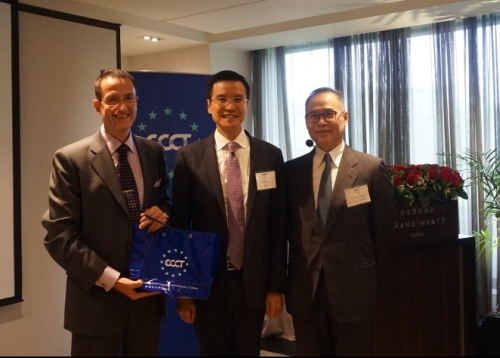Outlook for the global airline industry

Cathay Pacific will celebrate its 70th anniversary this year. It currently has a fleet of 200 aircraft and has ordered 69 more. The airline transported 17 million passengers in the first half of 2016.
Besides its flagship carrier, Cathay is the 100% owner of Dragon Air and has a 20% shareholding in Air China (which in turn has a 29.99% stake in Cathay). The investment in Air China gives the group exposure not only to China's growing passenger market but also the cargo business. Cathay also has a 60% share in Air Hong Kong, a joint venture with DHL. Besides airlines, the company has several subsidiaries engaged in the business of catering, laundry services and Hong Kong Airport Services.
Cathay and Dragon Air together operate 1,549 flights weekly, which includes 226 flights to Taiwan, over 400 flights to destinations in China, 345 to South East Asia, 109 to North America and 96 to Europe. Cathay is part of the Oneworld alliance of airlines, which collectively serve over 1,000 destinations globally. The company has over 33,000 employees, of which 26,000 are in Hong Kong, making the company one of Hong Kong's largest employers. This includes 16,600 Cathay Pacific staff and 9,300 in Cathay's subsidiaries. The company has been operating in Taiwan for 57 years and has over 600 local staff.
According to Chu, global airline passenger traffic has risen by an average of 5.5% annually over the past 10 years. 3.6 billion passengers took a flight in 2015, equal to half the world's population while cargo worth US$6.4 trillion was transported by air. Hong Kong International Airport took the top spot for handling cargo traffic in 2015 of 4.4 million tonnes and the third spot in terms of passengers (68 million), after Dubai (77 million) and London (70 million).
According to Chu, the aviation industry is a force for good in the world. It supports 62.7 million jobs and accounts for 3.5% of global GDP. It is a testament to the success of the industry that the cost of air travel continues to fall while safety continues to improve. There were only 136 air fatalities out of 3.6 billion passengers in 2015, compared to 17.4 road fatalities per 100,000 people.
The aviation industry is also committed to becoming greener. The International Air Transport Association (IATA) targets fuel efficiency reductions of 1.5% annually. Cathay's target is 2%, which it exceeded in 2015 by achieving a 2.7% improvement. According to Chu, the retiring of older aircraft and the imminent introduction of newer aircraft, especially the A350 and B787 Dreamliner, which are about 25% more fuel efficient, will result more overall efficiency and lower emissions in the years ahead. In addition, a global carbon emission trading scheme for international aviation will be decided this year. Making users pay for carbon emissions will help to maintain momentum towards further efficiency.
While the airline industry creates a lot of value for passengers and the economy, it is a tough business that does not keep a lot of value. The main reasons for this are fragmentation of the industry, monopolistic suppliers and because fuel accounts for 30-40% of costs. Competition among airlines, which provides a variety of choices and low prices, is great for consumers but wreaks havoc on airline margins. In terms of suppliers, there are only two major aircraft producers while airlines have no choice but to fly to major airports, giving them little bargaining power with airport authorities. Besides these challenges, airlines are currently struggling as a result of a slowing global economy. They also face frequent disruptions from political uncertainties and unrest or terrorist attacks or threats, which dampen enthusiasm for travel.
In Chu's view the future of the airline industry is bright, especially for the Asia Pacific region, which is the new centre of the global aviation industry and will remain so given its huge and expanding population and rising middle class. Nielsen estimates that the number of people in South East Asia joining the middle class (which they define as earning between US$16 and US$100 per day) will rise from 190 million in 2012 to 400 million by 2020. China will serve as both a huge source of global tourists as well as a tourist destination, providing huge business for airlines. According to the World Tourism Organisation, by 2020 there will be 200 million Chinese travelling aboard and more than 137 million tourists visiting China.
According to IATA statistics, the Asia Pacific region will have the highest number of new passengers by 2034. Airlines are expanding aggressively to meet anticipated demand. Based on statistics cited by Chu, Asian airlines increased their carrying capacity by 8.1% in the first half of 2016 and it is estimated that Asia will get most of the new aircraft produced over the next 20 years.
However, huge opportunities also come with challenges in terms of safety, infrastructure and risks of oversupply. Unless airports are expanded, there will not be enough capacity to meet the growing demand. Moreover, sophisticated traffic control systems and well-trained staff are essential for safety reasons. Chu said he is optimistic that the shortage of airline pilots can be solved given that the career of an airline pilot remains rewarding enough to attract applicants. It is just a case of providing the correct training.
Chu concluded with an overview of how Hong Kong has succeeded as an aviation hub thanks to liberal aviation policy, supporting infrastructure and an alignment of the interests of the government and the large home carrier (Cathay).
